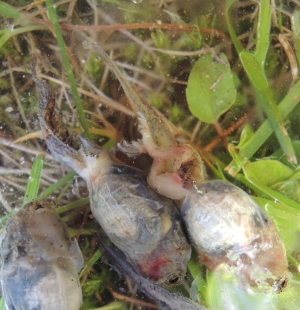Study Predicts Ranavirus as Potential New Culprit in Amphibian Extinctions
July 9, 2014

|
| Ranavirus infection could contribute to extinction of wood frogs in populations that are demographically isolated. (Credit: Thomas Brown) |
KNOXVILLE—Amphibian declines and extinctions around the world have been linked to an emerging fungal disease called chytridiomycosis, but new research from the National Institute for Mathematical and Biological Synthesis (NIMBioS) shows that another pathogen, ranavirus, may also contribute.
In a series of mathematical models, researchers showed that ranavirus, which causes severe hemorrhage of internal organs in frogs, could cause extinction of isolated populations of wood frogs if they are exposed to the virus every few years, a scenario that has been documented in wild populations.
The most widely distributed amphibian species in North America, wood frogs have been shown to be highly susceptible to ranavirus infection, particularly as tadpoles. But little research has been done into how ranavirus affects frogs at all stages of their life cycle — from egg to hatchling to tadpole to metamorph, the stage when they emerge as frogs. Little is also known about how the infection could hasten extinction in entire populations.
The study, published in the journal EcoHealth, investigates the effect of ranavirus on the entire life cycle of wood frogs in demographically isolated populations, where there is no movement of frogs into the population from surrounding areas.
The study used mathematical simulations based on long-term data sets from wild populations of wood frogs in eastern United States and laboratory data on the effects of ranavirus. It determined that the life stage during which a frog was exposed to ranavirus was one of the most important factors in determining extinction and declines.
Extinction was most likely to occur when the tadpole or metamorph was exposed to ranavirus at frequent intervals in small populations. Under the worst-case scenario, extinction could occur in as quickly as five years with exposure every year and 25–44 years with exposure every two years.
The egg stage had a 57 percent survival rate when exposed to ranavirus, which was high enough to prevent extinction. Scientists speculate that eggs have a greater survival rate than other stages because they are protected by a thick gelatinous membrane that may serve as a structural barrier or contain anti-viral properties.

|
| Dead and dying wood frog tadpoles showing skin shedding and hemorrhages in their well-developed legs and around their throats, from a pond in Brunswick, ME, in June 2013 where an estimated more than 200,000 tadpoles died in less than 24 hours. In the study, extinction was most likely to occur when the tadpole was exposed to ranavirus at frequent intervals in small populations. (Credit: Nathaniel Wheelwright) |
"Just as the chytrid fungus has decimated frog populations, the results of our study suggest that ranavirus infection too could contribute to extinction of amphibian populations that are demographically isolated," said lead author and NIMBioS postdoctoral fellow Julia Earl.
Amphibians are already considered the most imperiled of vertebrates, and a third of amphibians are threatened or endangered, according to the International Union for Conservation of Nature, the main international body that assesses the conservation status of species.
Disease may be playing a role in amphibians' extinction. Since the 1990s, chytridiomycosis, which has been called the worst disease affecting vertebrate animals in recorded history, has caused massive die-offs and species extinctions across the world, particularly in Australia, the Caribbean, and North, Central, and South America.
Ranavirus infections in amphibians have been known since the 1960s, but it wasn't until the 1980s when they were associated with large-scale mortality and disease.
Once exposed to ranavirus, in susceptible species like wood frogs, mortality can be as quick as three days. Transmission can occur through water, direct contact and when tadpoles scavenge other dead and infected frogs. There is no cure or treatment for the disease.
Citation: Earl JE, Gray MJ. June 2014. Introduction of ranavirus to isolated wood frog populations could cause local extinction. EcoHealth. DOI: 10.1007/s10393-014-0950-y [Online]
Media Coverage Highlights
Frog population decline linked to killer pathogen. LiveScience
Is ranavirus behind frog population declines? Science 2.0
#
The National Institute for Mathematical and Biological Synthesis (NIMBioS) brings together researchers from around the world to collaborate across disciplinary boundaries to investigate solutions to basic and applied problems in the life sciences. NIMBioS is supported by the National Science Foundation, the U.S. Department of Homeland Security, and the U.S. Department of Agriculture with additional support from The University of Tennessee, Knoxville.
CONTACT:
Catherine Crawley (865-974-9350, ccrawley@nimbios.org)
NIMBioS
1122 Volunteer Blvd., Suite 106
University of Tennessee
Knoxville,
TN 37996-3410
PH: (865) 974-9334
FAX: (865) 974-9461
Contact NIMBioS


